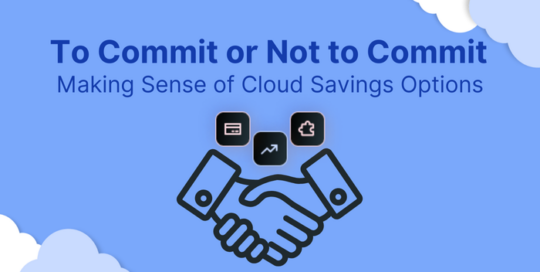Green Operations (GreenOps) is an approach to creating an eco-friendly cloud. The aim is to minimize energy waste, increase renewable resources, and decrease their carbon footprint on the planet.
Several public cloud providers are aiming to become carbon-negative. By 2030, Google Cloud plans to operate on carbon-free energy around the clock. Microsoft Azure has committed to being carbon-negative by 2030, and AWS aims to run its operations on 100% renewable energy by 2025.
This guide will cover GreenOps’ key concepts and how to integrate them to cut costs and lessen environmental impact.
What is GreenOps, and how does it make a sustainable cloud?
GreenOps integrates eco-friendly practices into cloud and business operations to minimize the ecological impact of technology use. This approach helps businesses leverage the power of the cloud while reducing energy consumption, optimizing resource utilization, and supporting renewable energy initiatives.
Adoption rates for GreenOps have been rising steadily. In 2024, the focus on cloud cost management, sustainability, and GreenOps is expected to increase by 35%, greatly impacting cloud resource use and energy efficiency.
Let’s go over and see what these strategies look like.
Principles and Practices of GreenOps
GreenOps involves implementing several sustainable practices:
Energy Efficiency
First, it’s about optimizing data centers and IT infrastructure to consume less energy. This involves leveraging FinOps practices to identify cost-saving opportunities by reducing unnecessary cloud resource usage.
GreenOps principles guide energy efficiency enhancement, making your cloud setup leaner and greener. By doing so, you not only help the environment but also significantly cut down on energy bills. (It’s a win-win for both financial and environmental sustainability!)
Resource Management
Next, GreenOps emphasizes reducing waste and promoting recycling within the organization. Implementing FinOps strategies ensures that cloud resources are used efficiently, minimizing digital waste. Together, these practices support both cost-effectiveness and environmental responsibility.
Sustainable Sourcing
Finally, all products and services must be sourced from environmentally friendly suppliers. Select cost-effective yet sustainable vendors who provide transparency in their operations and promote green practices.
Combining FinOps and GreenOps
Blending FinOps and GreenOps strategies benefits organizations by optimizing the cloud’s financial performance and environmental sustainability. Aligning financial management with sustainability goals helps control cloud spending and reduce the carbon footprint, ensuring resource efficiency, cost savings, and enhanced corporate responsibility.
So, what kind of benefits can be expected from this combo?
With over 30% of cloud use estimated to be wasted, the urgency for GreenOps is greater than ever.
Benefits of Integration
Cost Savings
Optimizing data centers and cloud infrastructure can help companies achieve significant energy savings. For instance, Google’s data centers utilize AI to reduce cooling energy use by up to 40%.
Environmental Impact
Implementing GreenOps can cut cloud data center energy use by 20-40%, bringing substantial environmental and cost advantages. This is done via resource optimization and energy-efficient infrastructure, lowering operational costs and enhancing sustainability.
Operational Efficiency
Right-sizing and auto-scaling cloud resources help companies use only what they need, boosting resource efficiency and cutting costs. Organizations that implement these practices can see an increase in resource utilization from 10-15% to 50-70%.
Regulatory Compliance
As many regions have already passed regulatory standards for environmental sustainability and others are considering future rules, you can keep pace with the game if you start implementing GreenOps policies now. Your compliance and legal teams will thank you for helping them dodge future penalties and other legal issues. We’ll go into more detail below about the new regulations entering the scene and how you can avoid potential legal fines—and help the environment!
Recent Environmental Regulations and GreenOps
Environmental regulations in Europe have been on the rise since the early 2010s. For example, EU regulatory reporting requirements like Germany’s Energy Efficiency act which requires a 26.5% reduction in carbon emission levels from 2008 to 2030 is a big incentivizer for companies to adopt GreenOps solutions. But the most recent initiative you should be aware of is CSRD.
The EU’s CSRD (Corporate Sustainability Reporting Directive) is driving major changes in GreenOps. The CSRD drives changes in company behavior to bring sustainability on part with mandated disclosure efforts, and went into full effect January 5, 2023. Approximately 50,000 companies in EU Member States had until July 2024 to incorporate these mandates. Penalties for non-compliance are determined by state and can result in fines.
The process of determining if a company is included in CSRD’s scope is complex. We recommend you consult your legal department to determine if your organization is included. There are a few general guidelines you can review to get an idea of if you should be worrying about CSRD or not:
- Does your company have securities listed on an EU-regulated market? If your company has securities listed on certain EU stock exchanges like Euronext Dublin, then you may need to be CSRD-compliant.
- Is your company considered a medium or small organization? If your company has less than €25 million in total assets, net turnover less than €50 million or less than an average of 250 employees, you might need to be CSRD-compliant.
- Is your company the parent company of a group considered a large organization? If not, then you may need to be CSRD-compliant.
| Regulation | Description | Impact on Organizations | How GreenOps Can Help |
| CSRD (Corporate Sustainability Reporting Directive) (EU, January 5, 2023) | Requires large companies in the EU to disclose environmental impact alongside financial data. | Increased reporting requirements and potential fines for non-compliance. | Streamline data collection and reporting for environmental metrics. Optimize resource management to reduce environmental impact. |
| Germany’s Energy Efficiency Act (2015) | Mandates a 26.5% reduction in carbon emission levels from 2008 to 2030. | Incentivizes companies to adopt energy-efficient practices. | Identify and implement energy-saving measures. Track & report energy consumption data. |
| Future Regulations | Anticipated environmental regulations at regional, national, and international levels. | Potential compliance challenges and increased operating costs. | Proactive adoption of GreenOps practices can help mitigate risks and costs. |
If you do think you may need to be CSRD-compliant and haven’t yet started on the process, GreenOps is the way to help your FinOps organization… but that’s not to say that you can seamlessly start integrating FinOps and GreenOps at the drop of the hat.
Pain points with GreenOps and solutions
So far, integrating a GreenOps strategy into a FinOps framework for cloud services looks like a win, but like any new cultural shift, there are bound to be challenges.
So, be prepared for these potential roadblocks when introducing GreenOps to the cloud.
Overcoming Common Challenges
Cultural Resistance
Employees may resist changes to learn new skills and adapt to new processes, especially if they already have a rhythm in their cloud environment.
Solution: Foster a culture of sustainability and financial accountability through training and communication. Engage employees by highlighting the long-term benefits of GreenOps and FinOps, including cost savings and positive environmental impact. Encourage participation and feedback to ensure everyone is on board with the changes.
Complexity
Managing both FinOps and GreenOps can be complex in the cloud. The integration requires managing multiple aspects of cloud operations, from cost optimization to sustainability practices, which can be overwhelming without the right tools and processes.
Solution: Utilize automated tools and technologies to simplify FinOps processes. Implementing cloud management platforms that can streamline operations and reduce the burden of manual management. Tools that provide real-time data and insights can help make informed decisions quickly and efficiently.
Measurement Difficulties
Measuring the impact of GreenOps and FinOps initiatives can be challenging. It involves identifying the right metrics, tracking progress in complex cloud environments, and ensuring data accuracy.
Solution: Establish clear metrics and regularly review progress. Define specific, measurable goals for financial and environmental performance. Track energy consumption, carbon footprint, cost savings, and resource utilization. Regular reviews and adjustments based on data insights will help maintain the effectiveness of these initiatives.
How is Anodot assisting in GreenOps practices?
As mentioned before, juggling various operational frameworks in the cloud can be challenging. Your company might be just getting the hang of FinOps and worry that adding another operational layer could disrupt cloud efficiency. But, as a certified FinOps cost management platform, we can help.
With Anodot, we can provide the tools for FinOps in the cloud, allowing you to concentrate on cloud sustainability without sacrificing cost efficiency and optimization.
Establishing Sustainable FinOps through Greenpixie Integration
We’re partnering with Greenpixie to seamlessly integrate cloud carbon emissions data into our FinOps platform, paving the way for an innovative solution in sustainable cloud management. Through this collaboration, we will unify cost and carbon emissions data within a single interface using Greenpixie’s ISO-verified methodology. This integration will give engineers precise insights to minimize cloud inefficiencies and environmental footprint.
With this partnership, we aim to offer customers:
- An integration for precise, real-time emissions data
- Optimization of cloud operations and promotion of sustainable practices
- Alignment of cloud efficiency with environmental responsibility
- Solutions to assist organizations in safeguarding the planet and their profits
- Effective tackling of global sustainability challenges
Read more about our collaboration for sustainable FinOps.
Harnessing Today’s Anodot Platform for Eco-Friendly Operations
With continuous monitoring and deep visibility, businesses gain the power to align FinOps, DevOps, and Finance teams to reduce their total cloud bill and implement GreenOps strategies effectively.
Here’s how:
Cloud cost dashboard: Multicloud Visibility—Anodot seamlessly combines all of your cloud spend into a single platform. Monitor and optimize your cloud cost and resource utilization across AWS, GCP, and Azure.
Eliminate Waste: Anodot’s easy-to-action savings recommendations enable your DevOps team to easily implement spending and service changes that can drive significant savings.
Allocate Costs: See cost causation and allocate spend by service, business unit, team, and app with deep visibility across AWS, Azure, GCP, and pod-level Kubernetes.
Enable FinOps: Avoid bill shock with near real-time alerts and insightful, ML-driven forecasting.
Granular Insights: Detailed tracking of spending and usage across Kubernetes clusters provides insights that no other cloud optimization platform offers. This allows businesses to identify under-utilization at the node level and optimize resource use, directly supporting sustainability efforts.
Not using FinOps yet, or need a partner to maximize your efforts? Let’s chat.
Conclusion GreenOps + FinOps = Sustainable Cloud
Organizations are starting to be mindful of how their operations contribute to carbon emissions and are working on reducing their carbon footprint. At first glance, working in the cloud may not appear to have a significant impact on the environment. However, powering data in the cloud consumes substantial energy, and inactive cloud resources result in wastage.
If you’re diving into GreenOps, understanding your FinOps and cloud costs can reveal where cloud waste occurs.
And having a partner who can show you that insight can greatly help your cloud become more green.
Together, let’s do our part and make a more sustainable cloud!





